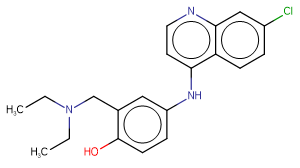
Amodiaquine
CAS No. 86-42-0
Amodiaquine( —— )
Catalog No. M21611 CAS No. 86-42-0
Amodiaquine is a synthetic aminoquinoline used to treat malaria.
Purity : >98% (HPLC)
 COA
COA
 Datasheet
Datasheet
 HNMR
HNMR
 HPLC
HPLC
 MSDS
MSDS
 Handing Instructions
Handing Instructions
| Size | Price / USD | Stock | Quantity |
| 2MG | 58 | Get Quote |


|
| 5MG | 87 | Get Quote |


|
| 10MG | 165 | Get Quote |


|
| 25MG | 287 | Get Quote |


|
| 50MG | 428 | Get Quote |


|
| 100MG | 614 | Get Quote |


|
| 200MG | Get Quote | Get Quote |


|
| 500MG | Get Quote | Get Quote |


|
| 1G | Get Quote | Get Quote |


|
Biological Information
-
Product NameAmodiaquine
-
NoteResearch use only, not for human use.
-
Brief DescriptionAmodiaquine is a synthetic aminoquinoline used to treat malaria.
-
DescriptionAmodiaquine is a synthetic aminoquinoline used to treat malaria.(In Vitro):Amodiaquine (10-20 μM; 4 hours) treatment suppresses LPS-induced expression of proinflammatory cytokines (IL-1β, interleukin-6, TNF-α and iNOS) in a dose-dependent manner.Amodiaquine (5 μM; 24 hours) significantly inhibits neurotoxin (6-OHDA-induced cell death in primary dopamine cells as examined by the number of TH+ neurons and dopamine uptake. The neuroprotective effect of Amodiaquine is also observed in rat PC12 cells.(In Vivo):Amodiaquine (40 mg/kg; intraperitoneal injection; daily; for 3 days; male ICR mice) treatment diminishes perihematomal activation of microglia/macrophages and astrocytes. Amodiaquine also suppresses ICH-induced mRNA expression of IL-1β, CCL2 and CXCL2, and ameliorated motor dysfunction of mice.
-
In VitroAmodiaquine (10-20 μM; 4 hours) treatment suppresses LPS-induced expression of proinflammatory cytokines (IL-1β, interleukin-6, TNF-α and iNOS) in a dose-dependent manner.Amodiaquine (5 μM; 24 hours) significantly inhibits neurotoxin (6-OHDA-induced cell death in primary dopamine cells as examined by the number of TH+ neurons and dopamine uptake. The neuroprotective effect of Amodiaquine is also observed in rat PC12 cells. RT-PCR Cell Line:Primary microglia Concentration:10 μM, 15 μM, 20 μM Incubation Time:4 hours Result:Suppressed LPS-induced expression of proinflammatory cytokines (IL-1β, interleukin-6, TNF-α and iNOS) in a dose-dependent manner.
-
In VivoAmodiaquine (40 mg/kg; intraperitoneal injection; daily; for 3 days; male ICR mice) treatment diminishes perihematomal activation of microglia/macrophages and astrocytes. Amodiaquine also suppresses ICH-induced mRNA expression of IL-1β, CCL2 and CXCL2, and ameliorated motor dysfunction of mice. Animal Model:Male ICR mice (8-10?weeks of age) induced ntracerebral hemorrhage (ICH) Dosage:40 mg/kg Administration: Intraperitoneal injection; daily; for 3 daysResult:Diminished perihematomal activation of microglia/macrophages and astrocytes.
-
Synonyms——
-
PathwayOthers
-
TargetOther Targets
-
RecptorNurr1
-
Research AreaInfection
-
IndicationMalaria
Chemical Information
-
CAS Number86-42-0
-
Formula Weight355.86
-
Molecular FormulaC20H22ClN3O
-
Purity>98% (HPLC)
-
SolubilityDMSO:71 mg/mL (199.52 mM)
-
SMILESCCN(CC)Cc1cc(Nc2ccnc3cc(Cl)ccc23)ccc1O
-
Chemical Name——
Shipping & Storage Information
-
Storage(-20℃)
-
ShippingWith Ice Pack
-
Stability≥ 2 years
Reference
1.Keita Kinoshita Koseiet al. A Nurr1 agonist amodiaquine attenuates inflammatory events and neurological deficits in a mouse model of intracerebral hemorrhage.[J]. Journal of Neuroimmunology 2019.
molnova catalog



related products
-
Clausine E
Clausine E is an inhibitor of fat mass and obesity-associated protein (FTO) demethylase activity.
-
2H-Naphth[2′,1′:4,5]...
2H-Naphth[2′,1′:4,5]indeno[1,2-d][1,3]dioxole, pregn-4-ene-3,20-dione deriv showed high local anti-inflammatory potency and high lung selectivity when tested on Sprague Dawley rats.
-
Thalidomide 5-fluori...
Thalidomide 5-fluoride is a chemical compound.



 Cart
Cart
 sales@molnova.com
sales@molnova.com


